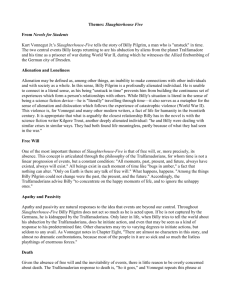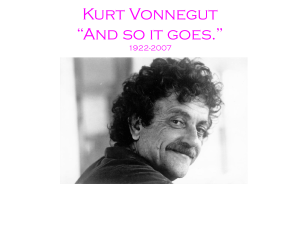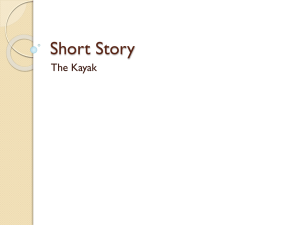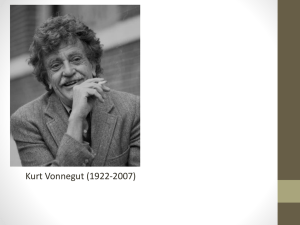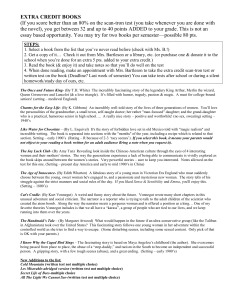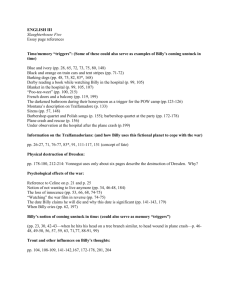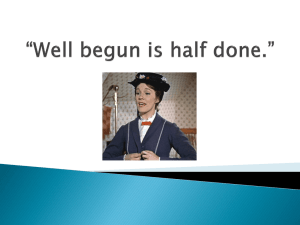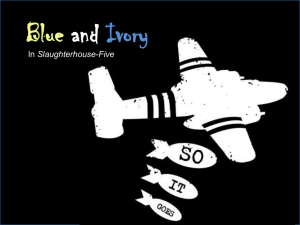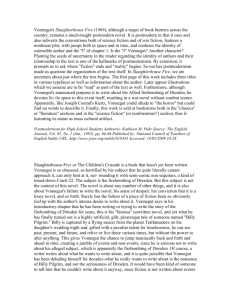Like Spoons on Christmas: Fractured Time, Ambivalence, and
advertisement
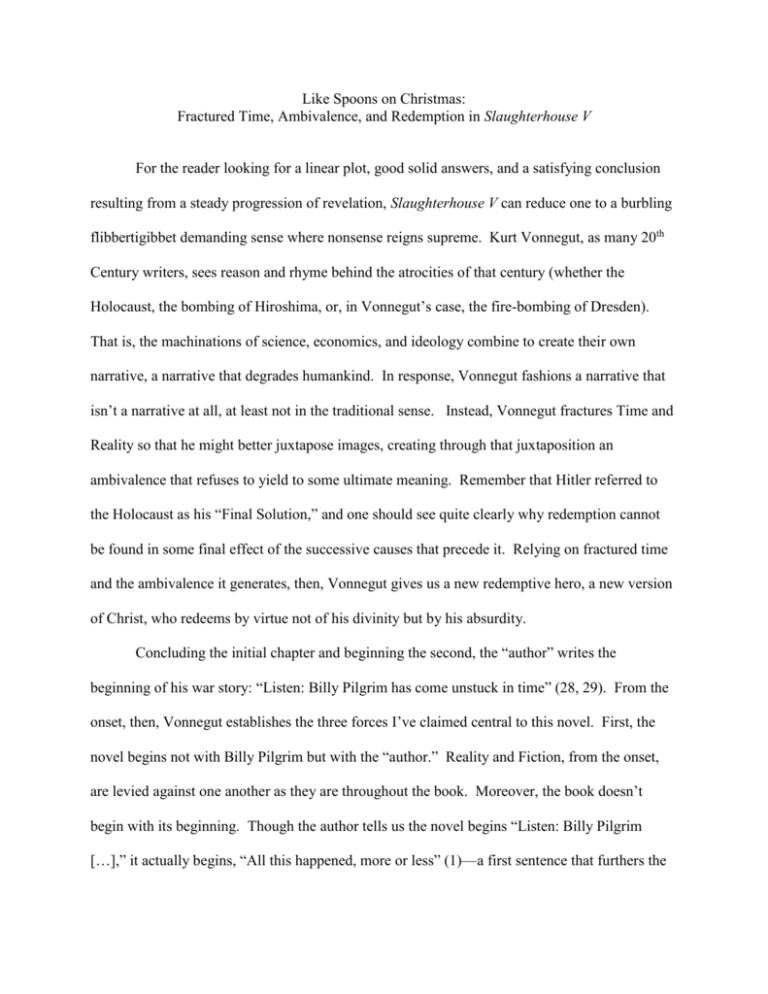
Like Spoons on Christmas: Fractured Time, Ambivalence, and Redemption in Slaughterhouse V For the reader looking for a linear plot, good solid answers, and a satisfying conclusion resulting from a steady progression of revelation, Slaughterhouse V can reduce one to a burbling flibbertigibbet demanding sense where nonsense reigns supreme. Kurt Vonnegut, as many 20th Century writers, sees reason and rhyme behind the atrocities of that century (whether the Holocaust, the bombing of Hiroshima, or, in Vonnegut’s case, the fire-bombing of Dresden). That is, the machinations of science, economics, and ideology combine to create their own narrative, a narrative that degrades humankind. In response, Vonnegut fashions a narrative that isn’t a narrative at all, at least not in the traditional sense. Instead, Vonnegut fractures Time and Reality so that he might better juxtapose images, creating through that juxtaposition an ambivalence that refuses to yield to some ultimate meaning. Remember that Hitler referred to the Holocaust as his “Final Solution,” and one should see quite clearly why redemption cannot be found in some final effect of the successive causes that precede it. Relying on fractured time and the ambivalence it generates, then, Vonnegut gives us a new redemptive hero, a new version of Christ, who redeems by virtue not of his divinity but by his absurdity. Concluding the initial chapter and beginning the second, the “author” writes the beginning of his war story: “Listen: Billy Pilgrim has come unstuck in time” (28, 29). From the onset, then, Vonnegut establishes the three forces I’ve claimed central to this novel. First, the novel begins not with Billy Pilgrim but with the “author.” Reality and Fiction, from the onset, are levied against one another as they are throughout the book. Moreover, the book doesn’t begin with its beginning. Though the author tells us the novel begins “Listen: Billy Pilgrim […],” it actually begins, “All this happened, more or less” (1)—a first sentence that furthers the initiates the reader in the ambivalence of the text—how can something ‘more or less’ happen? Things happen or they don’t—usually. The insistence that story begins “Billy Pilgrim has come unstuck in time” doubly creates the first fracture in time, “beginning” with the second chapter with the proclamation that time operates as, perhaps, it ought. Lastly, this so-called beginning introduces the theme of redemption while further deepening the ambivalent juxtaposition of reality and fiction, of absurdity and divinity. The name “Billy Pilgrim” introduces the religious motif via the protagonist’s surname, suggesting that the character will search out some greater truth. The mundane “Billy,” however, when coupled with “Pilgrim” confronts the reader with a name so utterly contrived that the reader cannot escape the artifice of it. Before we are told, then, that Billy went “to sleep a senile widower” and awoke “on his wedding day,” Vonnegut neatly establishes the crux of the riddle he has composed for us—packing into eight words his intent to seek out redemption via a fractured and absurd narrative. Tragedy has a way of shaking loose the moorings that bind us in time. In Shakespeare’s Hamlet, the title character tells us that “The time is out of joint: O cursed spite, / That ever I was born to set it right!” (5:1, 188-9). Vonnegut’s opening echoes that concern along with Hamlet’s desire to “set it right.” Indeed, the entire novel seems a fool’s errand to set right the crimes and the horrors witnessed by the “author.” Those atrocities become immediately unintelligible, without clear lines of demarcations separating real for fiction or even good from bad. The “author,” describes himself as “a trafficker in climaxes and thrills and characterization and wonderful dialogue and suspense and confrontations” (6), who has created an outline for a “Dresden story” that is “the best outline [he] ever made, or anyway the prettiest one” (6). That outline begins as it should, with a beginning and progresses toward an end (“and then there was all that middle part, which was the middle” [7]). Vonnegut mocks plot while demonstrating the real damage done him by the Dresden fire bombing. Though he’s claimed, for years, to be hard at work on an “anti-war” novel concerning Dresden, he has never worked on it, let alone finished it. At best, he completed a “pretty” outline with plot-lines of various color, indicating various characters and their demise. Worse than the inability to write it, the outline bleeds into the author’s “real” life, obfuscating any delineation between the two. Describing the end of the outline, the story proceeds through the author’s biography, never bothering to explain when the “story” ends and “life” begins. This rent between artifice and actuality marks the novel as a whole, particularly the juxtaposition of Billy Pilgrim’s “real” life and his time spent on the planet of Tralfamadore. Initially, the reader might interpret this juxtaposition in one of two ways: either the Tralfamadorians are real or they are delusions of a war-addled brain. Or, the reader might chose to believe both. Vonnegut wants us to seek redemption not in any neat decision about the validity of this or that reality, or the veracity of this or that claim made by an “author” who may or may not be “Vonnegut.” In the end, each world reveals itself as plastic as the others, each equally contrived. Vonnegut wants us to seek our redemption in the continued tension between the worlds he’s set against each other when he disrupts time at the onset of his novel. During his abduction by the Nazi’s, Billy Pilgrim finds himself a passenger on a freight train, destined for a work camp. On this train, “Billy Pilgrim neslted like a spoon with the hobo on Christmas night, and he fell asleep, and he traveled in time to 1967 again—to the night he was kidnapped by a flying saucer from Tralfamadore” (90). Vonnegut weaves together three separate realities. While one could claim a suffering Pilgrim fantasized some escape from a freight car to a flying saucer, trading one abduction for one considerably less cruel,” the assumption ignores this “dream” includes his “past” life as well, making equally dubious Billy’s life with his wife, Valencia. After all, the “nestled like a spoon” on the boxcar finds echo in the description of Billy and his wife in bed, “nestled like spoons in their big double bed” (91). Vonnegut so thoroughly braids together each of the story lines (including that of the “author”) that the reader cannot reliably sort out what is true from what is false, “more or less.” Rather than deciding upon the relative validity of this or that story, hoping to piece together from the fragments what “really happened,” the reader would better understand the text by accepting the absurdity of all that happens, beginning with the shape of the novel itself. The Tralfamadorians offer Billy what turns out to be one useful way of reading the novel in which he unwittingly plays a role. Describing their literature, the aliens claim that “There is no beginning, no middle, no end, no suspense, no moral, no causes, no effects. What we love in our books are the depths of many marvelous moments seen all at one time” (112). Slaughterhouse V, indeed, has no beginning (since its “beginning” is dislocated to chapter 2), no middle, and no end. Nor has it any moral. The moment the author tells us, from the beginning, will provide the climax, the death of poor Edgar Derby, who stole a teapot, never occurs. Vonnegut simply writes, just before concluding, “Somewhere in there the poor old high school teacher, Edgar Derby, was caught with a teapot he had taken from the catacombs. He was arrested for plundering. He was tried and shot. So it goes” (274). No death is meaningful, not even the climactic death. Indeed, the “climax” seems the least important death in the novel. We should not look for meaning in plot, this moment tells us. As the Tralfamadorians do, we should look see the novel as a whole, as simultaneous rather than as a progression, preserving the tension between the images. Furthering this convolution of reality with fiction and of absurd narratives that comment upon the larger text, Vonnegut offers the symbol of redemption long coming throughout the novel, that of Jesus Christ. Christ, however, appears not as divine Song of God, but as an absurd nobody in the text of fictional Sci-Fi writer Kilgore Trout, a narrative that parallels, in theme, the hapless life of Billy Pilgrim. The parallels encourage the reader the reader to wonder if Billy has hallucinated a great deal, drawing his inspiration from his favorite “trafficker in climaxes and thrills.” Christ, as Trout writes him, is a “nobody, and a pain in the neck to a lot of people” (139). God, angry at the murder of this nobody, informs the people that he “was adopting the bum as his son” and that, from then on, “He will punish horribly anybody who torments a bum who has no connections” (140). Vonnegut has gone out of his way throughout the novel to draw the comparison between Billy and Christ. At various times, the novel instructs the reader to “listen,” echoing the command “those with ears to hear, listen” of Christ, concluding his parables. Vonnegut also peppers the text with references to crucifixion, including the “pitiful” Christ on the cross Billy hung in his room as a child (48). Divinity, we are to believe, cannot carry the load in this world. Only through a “bum with no connections,” Billy himself, can we find some redemption following the war and, in particular, the Dresden fire-bombing. Mocking the instruments of war, Vonnegut writes: “Listen—on the tenth night the peg was pulled out of the hasp on Billy’s boxcar door, and the door was opened […]. Billy coughed when the door was opened, and when he coughed he shit thick gruel” (101). The event, the narrator tells us, accords with Newton’s Third Law of Motion, that for every action, there is an equal and opposite reaction—“This can be useful in rocketry” (101). Again, Vonnegut uses the parable form to create an absurd juxtaposition of “high” and “low” values. Bodily fluid, crass humor, and the mundane undermine reason and divinity. Reason and divinity, after all, got Billy Pilgrim (and the rest of us) into this mess to begin with. By violating the most basic element of narration, that things occur in chronological order, Vonnegut is able to better bring about such juxtapositions, allowing him to create a world in which each “reality” is equally real and equally artificial. Only by disallowing any “official” reality, Vonnegut tells us, can we find some way out the damage the human race has inflicted upon itself. The absurd, then, offers meaning where official history fails, which is why the bird song serves as the only logical ending: Poo-tee-weet? Works Cited Vonnegut, Kurt. Slaughterhouse V. 1969. NY: Dial Press, 2005.

